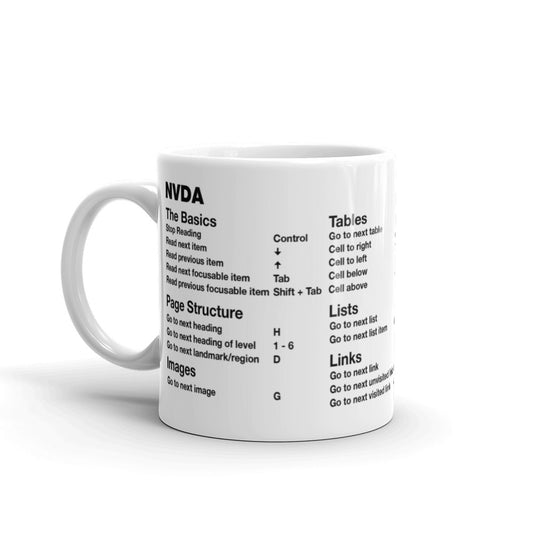Keyboard Accessibility Best Practices

One assistive technology that we all have available to us is the keyboard. With the keyboard alone, anyone should be able to navigate and complete a task available online, just as a mouse user would.
For some people, specifically those with a motor impairment who are unable to use a mouse or trackpad, the keyboard is the primary method of navigating the web and interacting with user interfaces.
What's great about the keyboard is the most of us are likely fairly familiar with this device which makes testing with a keyboard alone quite easy.
Let's take a look at a few ways to ensure accessibility for keyboard-only users.
Focus indicator
One of the most basic aids to help people navigate an app with ease and confidence (and is baked into every site by default) is the focus indicator.
What is the focus indicator? It's the visual indicator of where you currently are on a page when navigating by keyboard alone. Think of the focus indicator as the mouse cursor for the keyboard!
Load up your favorite site and start pressing the Tab key. Is there any indication of where the cursor currently is on the page? If you're in Chrome or Safari the default indicator is a blue outline, where Firefox and Internet Explorer/Edge features a dashed black outline.

For people with motor disabilities or any other impairment (temporary or permanent) which prevents using the mouse, navigating with the keyboard is the next best option.
Additionally, those who consider themselves "power users" who prefer the keyboard over using the mouse, such as filling out long forms, will also greatly benefit.
When you use the Tab key on a site, the keyboard cursor will appear and move from one HTML element to the next. Using Shift + Tab moves the keyboard cursor backward through the page. The elements highlighted are considered to be "naturally" focusable. Elements such as links, buttons, form inputs, etc, all receive keyboard focus by default and should highlight when the cursor moves from one to the next.
If you can't see the cursor on the page, you've got an accessibility issue
Sometimes during the design or development of a project, the request is made to remove the focus indicator ring. This is usually a result of the outline being displayed on mouse interaction which can be viewed as a negative cosmetic result.
Don't do this…
*:focus {
outline: none;
}
Without a focus indicator, a sighted keyboard-only user will not know where they are on the page when navigating content. This is a significant accessibility issue where keeping the default focus indicator will have a huge impact in the usability of your site.
While it is strongly recommended to not remove the default indicator, there are a few workarounds which could be used as a replacement which we'll discuss soon.
Custom focus indicator
Using CSS, it is possible to create your own focus indicator. With a bit of code such as…
*:focus {
outline: solid 3px red;
}
…you can create a custom focus indicator. This places a solid red outline around focusable elements.
When implementing a custom outline, there are a couple of things to keep in mind:
- Ensure the contrast ratio of the indicator against the background is high. If people can't see the focus indicator then its purpose is lost.
- Make it consistent. Since a custom focus indicator will be unexpected on the first visit, it's a good idea to keep things consistent and predictable throughout the user experience of the site.
Detect keyboard/mouse usage
There's been lots of great work done recently on detecting when someone's using a mouse or a keyboard to navigate site content. In doing so, designers are able to create a custom, highly visible focus indicator for keyboard users only. Mouse users would be free to rely on only the mouse cursor as their indicator.
This technique is not yet built directly into browsers. However, there are third-party code snippets (also called a "polyfill") available to gain this functionality.
Two of which worth checking out include:
WCAG success criteria
This comes back to WCAG 2.4.7 Focus Visible which states:
"Any keyboard operable user interface has a mode of operation where the keyboard focus indicator is visible."
Focus order
If you're familiar with CSS Flexbox or Grid, you might know that it's easy to manipulate the order of content using only a few CSS properties. For example, if you need to move a right bar container to the left side of the screen, this can be accomplished by adding one line of CSS.
The issue here is when someone is using the keyboard, screen reader, or any input that's not a mouse, the focus indicator may jump around the screen unexpectedly. In moving the right bar container to the left via CSS, the HTML used to generate the page content remains in the same position. As a result, the keyboard focus order would move from top header bar to the main content container on the right, then back to the top left of the page, finally to the footer content.
Ensure the visual order of content matches the HTML order
This is an issue when it comes to people with low-vision who rely on zoom software, or someone with a cognitive impairment who may become confused from the unexpected movement from one part of the screen to another. For this reason alone, it's recommended to ensure the visual order of content matches the HTML order the browser interprets on page load. You'll create a much more comfortable and predictable user experience as a result.
WCAG success criteria
This comes back to WCAG 2.4.3: Focus Order which states:
"If a Web page can be navigated sequentially and the navigation sequences affect meaning or operation, focusable components receive focus in an order that preserves meaning and operability."
Focus management
Focus management is a method used to willfully and purposefully move the keyboard cursor from one element to another on behalf of the user. This technique should only be used when absolutely necessary as to not create more work for the user when an unexpected shift in focus has occurred.
An example of focus management that we get from the browser for free is when we activate the Tab key in a form field, the focus is automatically sent to the next field in the set. Or, when moving from link to link, focus moves from the top of the document to the bottom. When using native elements, the browser takes care of moving and managing focus position for us.

However, when it comes to creating a non-native control or widget, such as a modal window which we'll look at in greater depth later, we need to manage the focus position on behalf of the user.
How we accomplish this is by use of the tabindex attribute.
The tabindex attribute
The tabindex attribute can be applied to any HTML element in order to help manage focus but should be restricted in its use to a few use cases.
Let's look at the values we can assign to this attribute and the result of each.
tabindex="-1"
The value tabindex="-1" allows a non-focusable element to programmatically receive focus via JavaScript, but does not add the element to the natural focus order. This means when someone is navigating by the Tab key, any element with a tabindex value of -1 will not receive focus.
For example, when opening a modal window, use JavaScript to apply the tabindex="-1" attribute to the modal window container, then call the container's focus() method to apply keyboard focus. This allows the user to Tab forward from this point, discovering the modal window content as expected.
tabindex="0"
The value tabindex="0" allows a non-focusable element to receive focus and includes the element within the natural focus order. With this set on a non-focusable element, when someone is navigating via Tab key, that element with its tabindex attribute set to a value of 0 will receive focus.
For example, if there was a need to attach a click event handler to something like a div element, applying tabindex="0" would allow the div to receive keyboard focus when navigating through page content.
tabindex="1" or higher
Any tabindex value greater than 0 is considered an anti-pattern and should be avoided. For example, if an element featured tabindex="5", this would send focus to this element first when navigating through page content, then when navigating away, the focus would return to the first element in the natural tab order.
As previously discussed, the browser automatically handles focus management between natively focusable elements. With this in mind, let's rely on the browser to organically handle focus as determined by the order of elements within the document.
Refrain from adding
tabindex="0"everywhere!
When it comes to navigating non-focusable elements, such as plain text content, headings, or images, it's important to note that assistive technology, such as screen readers (which will be discussed in more detail later), have built-in functionality to read and consume these types of content.
After learning about using the Tab key to move around a webpage and the tabindex attribute, you may be tempted to place tabindex="0" on everything in order to ensure a screen reader user is able to Tab to these elements. Please refrain from doing so. This is considered an anti-pattern as this will cause more work for keyboard-only users to move around and consume the content they're interested in.
With some exceptions, only elements to receive the tabindex="0" attribute would be those with an action applied, such as a JavaScript click event handler. Leave all other elements out of the natural tab order, otherwise, keyboard-only users would have to press the Tab key many times just to reach links at the bottom of the page, resulting in a frustrating user experience.
A quick note on autofocus attribute
Similar to using the tabindex attribute with a value greater than 1, the autofocus attribute behaves in a similar manner, except that whatever element features this attribute, that element will automatically receive focus on load.
The autofocus attribute is kind of like dropping into a movie about 15 minutes in; you can sort of figure out what's going on, but really, you wish you'd just been on time to watch the movie from the beginning. Now you're confused about what's happening, hungry for not being able to grab some popcorn, and are feeling a little annoyed. That's what experiencing autofocus is like for screen reader users (except perhaps the hungry part, but hey, you never know.)
For this reason, autofocus is considered an anti-pattern and should be avoided.



